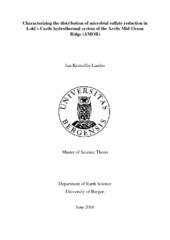| dc.description.abstract | Studies on the distribution of microbial sulfate reduction, and its impact on the global carbon and sulfur cycle, have mostly been conducted in shallow and deep-marine sediments. Little is therefore known about the ecological impact that sulfate reducing bacteria have on element cycling in ecosystems that is associated with the nutrient rich hydrothermal sediments. The chemical disequilibrium created by the mixing of hydrothermal fluids and seawater, nourish a diversity of primary producers that provide nutrients for the anaerobic heterotrophic community. Diffuse venting areas, such as the barite field on the eastern flank of the hydrothermal mound at Loki`s Castle, are promising target sites for exploring the impact of biogenic processes as temperatures are within the biological window. This study aims to characterize the distribution of sulfate reducing bacteria at this diffuse venting area by integrating direct measurement of sulfate reduction rates with geochemical analyses of pore fluids and microbiological methods. The spatial distribution of the fluid compositions and flow patterns seems to determine the distribution of the metabolically functional groups in the barite field, and functions as a geochemical constraint on the chemoautotrophic primary production. Hence, the divergent fluid pattern and energy supply determines the organic carbon production, which in turn determines the distribution of the heterotrophic community. This is reflected in the distribution of sulfate reduction, where sulfate reduction rates varied between 6-132 pmol/cm^3 d in substrate-poor parts of the mound to 110 nmol/cm^3 d in substrate-rich sediments. Sulfate reduction rate were also measured in a barite chimney, which was associated with effluent that was characterized by elevated concentrations of methane and H2. The geochemical measurements show a high correlation between the hydrothermal fluid signature, organic carbon production and the distribution of the mesophilic heterotrophic sulfate reducing bacteria. The diffuse venting area displays temperatures that vary between 7.8 °C in the sediments with low activity, to ~20 °C in the chimney effluent. This provides habitable conditions for mesophilic and psychrotolerant members of Desulfobacterales, Desulfarculales and Desulfuromonadales order, which were all affiliated with the Deltaproteobacteria phylum. One psychrophilic sulfate reducing bacteria, Desulfofaba gelida, was detected in sediments that were associated with the lowest rates. The variable CH4 and H2 concentration between areas with high flow rate and low flow rate give strong indications for an additional deep sub-surface sulfate reduction zone, where anaerobic oxidation of methane coupled with sulfate reducing bacteria are an important sulfate sink, in addition to H2 consumption by chemoautotrophic sulfate reducers and/or methanogens at more elevated temperatures | en_US |
